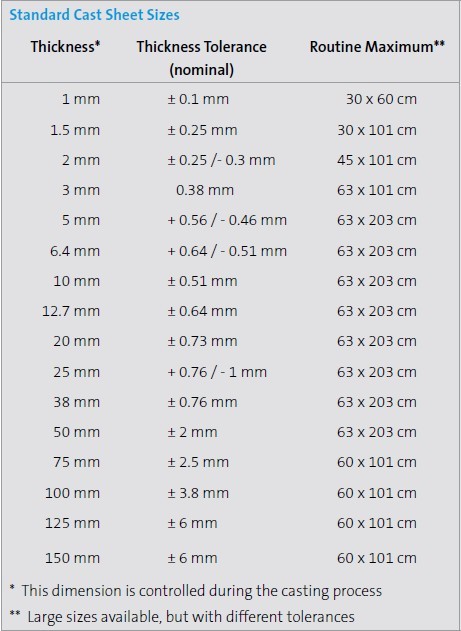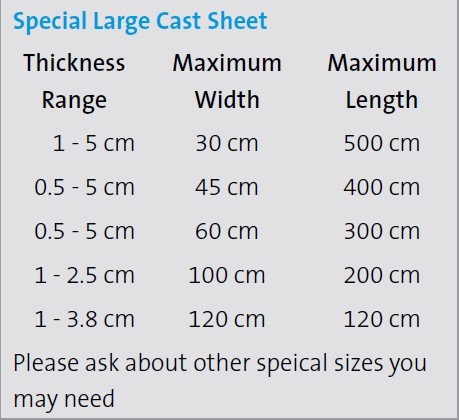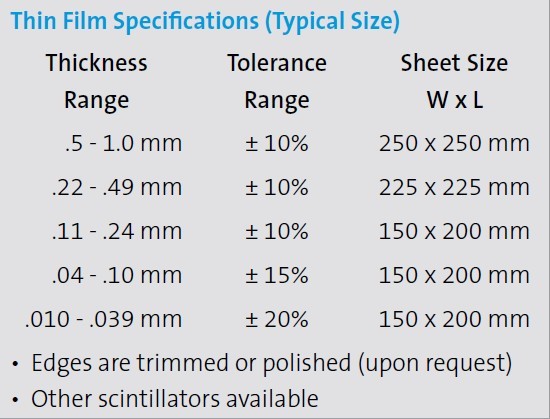Plastic Scintillators
A plastic scintillator consists of a solid solution of organic scintillating molecules in a polymerized solvent. The ease with which they can be shaped and fabricated makes plastic scintillators an extremely useful form of organic scintillator.
General Description –
The scintillation emission of a typical plastic scintillator has a maximum around 425 nm. Plastic scintillators are characterized by a relatively large light output — typically 25-30% of NaI(Tl) — and a short decay time of around 2ns. This makes the material suited for fast timing measurements.
All plastic scintillators are sensitive to X-rays, gamma rays, fast neutrons and charged particles.
Special formulations are available for thermal neutron detection or with improved X-ray efficiency. Plastic scintillators are the most popular scintillation material for use in calorimeters, time of flight detectors, nuclear gauging and large area contamination monitors.
The exact emission wavelength and decay time depend on the type of organic activator and on the host material. A large number of different plastic scintillators are available, each for a specific application. General characteristics of plastic scintillators are presented in another section of this brochure.
Availability –
Our plastic scintillators are produced in a wide variety of shapes and sizes. Cast sheets are the most commonly used forms.
You also can obtain precision thin sheets, thin film, rods, annuli, ingots and large rectangular blocks.
We supply most solid scintillators with their surfaces prepared to optimize light collection. For cast sheets, the cast surfaces are untouched, and the edges are machined and polished or diamond milled.
Rods, annuli and blocks are machined and polished, or coated with a diffuse reflector paint such as BC-620. Such a reflector is used only when there are few reflections of the scintillation light off the scintillator surfaces before the light reaches the PMT. Most applications require finished surfaces.
You can also obtain scintillators as finished detector assemblies. These incorporate light guides, photomultiplier tubes, special radiation entrance windows, and light tight wrappings (or metal housings).
Thin Films –
Thin films are ideally suited for charged particle detection and fast timing applications. We supply thin films in the following blue-emitting (410 to 430 nm) scintillator formulations:
-
BC-400 General purpose
-
BC-404 Highest light output; ideal for beta detection
-
BC-418 Fast timing material with decay time of 1.4 ns
-
BC-422 Fast timing material with decay time of 1.6 ns
BC-490 Plastic Scintillator Casting Resin –
BC-490 is a partially polymerized plastic scintillator that can be cured to full hardness by the end user. The scintillator thus formed is clear, with scintillation and mechanical properties similar to those of our general purpose plastic scintillators. It is most frequently used in applications that require other materials to be imbedded in the scintillator and those that require unique shapes to be cast, often in special holders.
BC-490 is supplied in complete kits with detailed instructions. Each kit contains three parts: partially polymerized scintillator resin, catalyst and catalyst solvent.
A green-emitting version, BC-490G, is also available.
Plastic Scintillators
Plastic sheets cast from the monomer ensure the highest light yield and best internal light transmission. All raw materials undergo extensive purification prior to polymerization and the finished sheets exhibit highly uniform scintillation and optical properties. Scintillators are machined to final dimensions using diamond tooling to provide optimum quality surfaces for total internal reflection.



Properties of plastic scintillator
| Base material |
Polystyrene |
| Density(g/cm3) |
1.05 |
| Refractive Index |
158 |
| Soften temperature(℃) |
75-80 |
| Light output(Anthracene) |
50-60% |
| Decay time(ns) |
2.4 |
| Wavelength of emission maximum(nm) |
415 |
| H/C ratio |
1.1 |
| Hygroscopic |
No |
NOTICE: We can customize various sizes of crystals according to the demand of the customers.
More:
